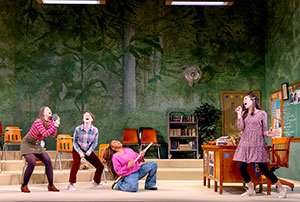 *
*
Review By Off the Shelf Correspondent Andy Hoffman
Setting a show in a school brings up so many production problems. How do you maintain the illusion of the adults playing kids and that the teacher/student power dynamic has actual consequences? The Huntington Theatre shows how with John Proctor is the Villain, tightly written by Kimberly Belflower and expertly directed by Margot Bordelon.
This production takes the audience right back into high school. The actors dress and speak like teenagers and gallop awkwardly around the stage as they would in a high-school classroom. From the scrunchies on their wrists to the oddly knowing innocence, this cast has embraced their younger selves.

John Proctor is the Villain
A play by Kimberly Belflower
Huntington Theatre, at the Calderwood Pavilion through March 10, 2024
The young people connect to their identities through Billie Eilish, Lorde, and Taylor Swift and they erupt into fits of laughter and screaming as teens do. The young playwright went home to rural Georgia after she completed her education and used the familiar location to channel her own youth into this play. They completely brought the audience into their world, as evidenced by the spontaneous standing ovation at the final curtain.
John Proctor is the Villain is set in a small-town high school in rural Georgia. The two faculty members we meet – English teacher Carter Smith and guidance counselor Bailey Gallagher – both graduated from this school, which creates an insular, even protected, environment for the rest of the characters, all students. The play’s subject, gender relations, makes the realism of the production even more powerful. We open in Mr. Smith’s English class, doubling as the sex-education course due to a faculty shortage. Japhet Balaban comes across as the incredibly cool and devoted teacher and he leads his students into the unit on Arthur Miller’s The Crucible. He gives his students the standard interpretation of the play, Miller’s indictment of anticommunist fervor played as the Salem Witch Trials, in which John Proctor’s refusal to save himself by impugning others seems heroic. The teenage girls in his class have a different point of view about John Proctor’s character; the play tells us why.
Set in the recent past, the students run squarely into political reality when they want to start a school club to explore feminism, of particular interest in the wake of the #metoo movement. The guidance counselor tries to break the news that the community would likely object to their club, but Mr. Smith comes to the rescue as both the faculty sponsor and with a different name that will deflect rancor.
The community context comes into the classroom in the free-wheeling conversation among the club members, as when Beth, a high-schooler who always apologizes for her opinions and the main instigator for forming the club, confesses that she really thought of the club as a Christian feminist organization. Her classmates are as baffled by this perspective as the audience is. The church remains an offstage character throughout the play, as membership and activity there stands in for upstanding moral behavior.
The play we see on the Calderwood stage unfolds like a parallel commentary on the action of The Crucible, as the students fumble their way to insight. Newcomer Nell, a Black student transferred from Atlanta, brings her classmates a slightly more worldly perspective.
In truth, they have plenty of worldliness among themselves. We learn early in the play that Raelynn and Lee, a couple since the fourth grade, ran into an explosive problem when Lee slept with Raelynn’s best friend Shelby, who subsequently disappeared from school for half a year. Did Shelby become pregnant? Did she have a breakdown? No one knows, especially not Raelynn, who simultaneously hates and misses her bestie. The action of the play accelerates to break-neck speed when Shelby returns unexpectedly. Her revelations turn the school upside down and bring the action of The Crucible and the action of John Proctor is the Villain into a duet. The exhilarating ending brings out both the best in the cast and the audience. Join the standing ovation at this exuberant performance.















Reader Comments